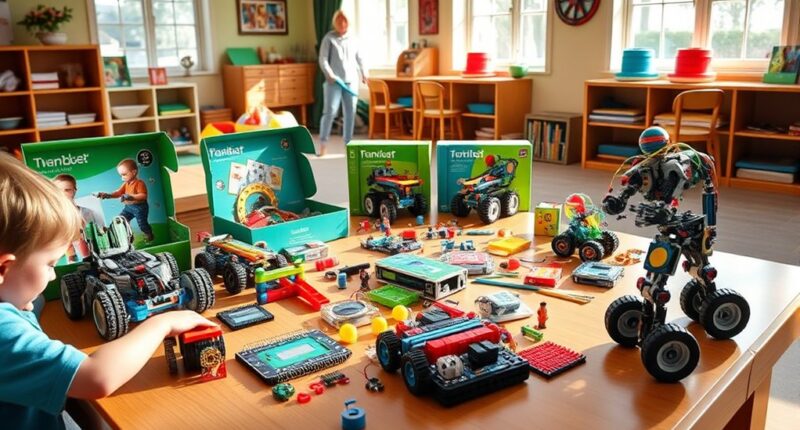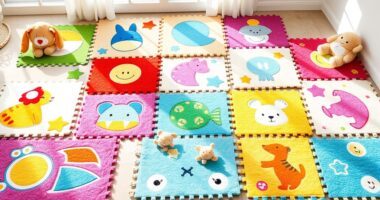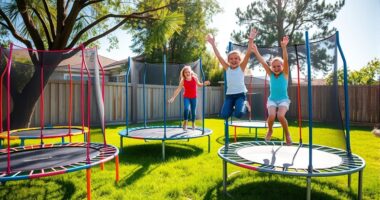If you’re looking for the best engineering kits for kids, I highly recommend the HOMETTER Educational Building Toys and the Engino STEM Toys, both designed for hands-on learning. The engaging and creative projects of the NATIONAL GEOGRAPHIC Da Vinci Catapult Model Kit will thrill older kids, while the ELEGOO UNO R3 Smart Robot Car Kit introduces essential robotics concepts. Each kit offers unique features that foster STEM skills. Curious about more exciting options? Let’s explore together!
Key Takeaways
- Diverse Options: Choose from various engineering kits like building toys, robotics, and model engines to cater to different interests and age groups.
- STEM Focus: Kits emphasize STEM learning, fostering critical thinking and creativity through hands-on activities and interactive projects.
- Age Appropriateness: Ensure the kit matches the child’s age for an optimal balance of challenge and safety during assembly.
- User Engagement: Look for kits with interactive features, customizable projects, and collaborative opportunities to enhance enjoyment and learning.
- Quality and Instructions: Check for positive feedback on durability and clarity of instructions to ensure a smooth building experience.
HOMETTER Educational Building Toys, STEM Learning Toy, 10 in 1 Construction Set for Kids
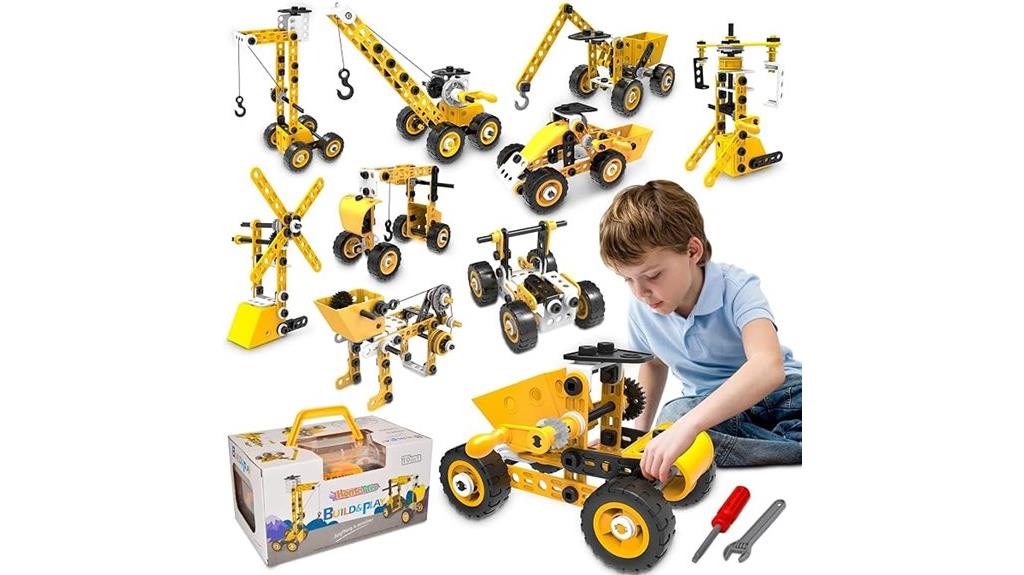
If you’re looking for an engaging way to spark your child’s interest in STEM, the HOMETTER Educational Building Toys set is a fantastic choice. With 10 different construction designs, like a bulldozer and a windmill, it keeps kids entertained while enhancing their STEM skills. I love how easy it is to assemble, though I recommend supervising younger kids since some instructions can be tricky. It’s perfect for ages 3 to 12, engaging them for hours. Plus, it’s a great gift idea for birthdays or holidays. Overall, it’s a fun way to combine play with learning!
Best For: Children aged 3 to 12 who are interested in construction and STEM learning through play.
Pros:
- Encourages STEM skill development and enhances concentration and hand-eye coordination.
- Offers 10 different construction designs, providing variety and extended playtime.
- Suitable as a gift for various occasions, appealing to kids who enjoy building and engineering toys.
Cons:
- Assembly instructions can be challenging to follow, potentially requiring adult supervision.
- Some vehicles may require re-tightening after assembly, which can be inconvenient.
- Mixed feedback regarding the quality and effectiveness of the assembly process.
Engino STEM Toys for Kids (Buildings & Bridges Construction Kit)

The Engino STEM Toys Buildings & Bridges Construction Kit is an excellent choice for kids aged 9 and up who are enthusiastic to explore the world of engineering and design. This kit lets kids build nine working models, including houses and bridges, using easy-to-follow instructions and a 3D interactive app. I love how it teaches essential design principles while engaging their creativity. With a customer rating of 4.6 stars, many appreciate its educational value and quality materials. It’s suitable for boys and girls, and perfect for classroom activities or family fun. Overall, it’s a fantastic way to spark interest in STEM!
Best For: Kids aged 9 and up who are interested in engineering and design, making it a great educational tool for both classroom and home use.
Pros:
- Engaging construction experience that promotes creativity and critical thinking.
- High educational value, teaching children about design principles and structural forces.
- Suitable for both boys and girls, encouraging collaborative learning and family activities.
Cons:
- Some users report challenges with the clarity of instructions and assembly difficulties.
- May be less suitable for younger children or those not mechanically inclined without adult assistance.
- Requires AA batteries, which may be an additional cost for some users.
STEM Learning Toys Creative Construction Engineering Building Set for Ages 3-10
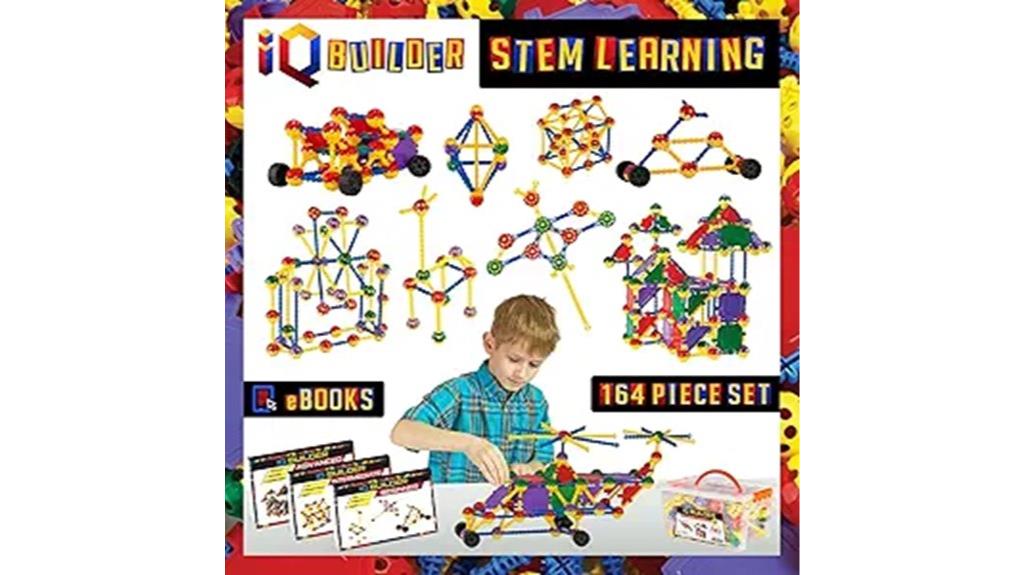
Perfect for children aged 3 to 10, the IQ Builder STEM Learning Toy fosters creativity and critical thinking while introducing the fundamentals of engineering. I love how it emphasizes STEM skills, encouraging kids to think critically and solve problems. With a compact size and lightweight design, it’s easy to store and handle. I’ve noticed that kids stay engaged for hours, exploring versatile building options. However, some designs require additional sets for complexity, and the manual is only downloadable. Despite these minor drawbacks, it’s a fantastic gift that sparks imagination and is highly recommended by teachers worldwide.
Best For: Children aged 3 to 10 who are interested in building and engineering activities that promote STEM learning.
Pros:
- Engages children for hours, promoting creativity and imaginative play.
- Encourages critical thinking, reasoning, and problem-solving skills.
- Compact and lightweight design makes storage and handling easy.
Cons:
- Many complex designs require multiple sets to fully realize.
- Instruction manual is only available for download, not in printed form.
- Some children may struggle if they cannot match designs exactly.
Engino STEM Toys: Physics Laws Construction Toys for Kids 9
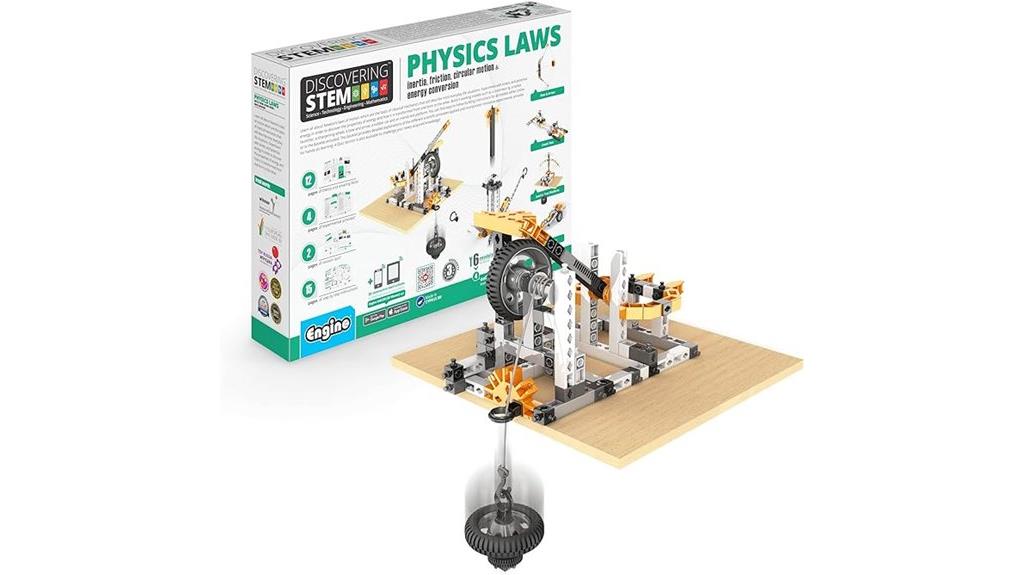
Designed specifically for kids aged 9 and up, Engino STEM Toys stand out as an engaging way to explore fundamental physics laws like inertia and friction. I love how this set lets kids build six working models, such as a rocket launcher and crash test rig. The easy-to-follow instructions, along with fun experiments and quizzes, make learning enjoyable. Plus, the interactive 3D app adds a tech twist! Many parents share how their kids are captivated by building and experimenting, making it a fantastic gift. Just keep in mind the language barrier and app access may require some extra steps.
Best For: Engino STEM Toys are best for children aged 9 and up who are interested in exploring physics through hands-on building and experimentation.
Pros:
- Engaging way to learn fundamental physics laws like inertia and friction through interactive models.
- Includes fun experiments and quizzes that enhance the educational experience.
- Accompanied by an interactive 3D app that adds a modern tech element to the learning process.
Cons:
- Some users reported a lack of printed instructions, which may be challenging for those without access to smartphones.
- Language barriers exist as instructions and app features are primarily in English.
- Access to certain manuals may require inconvenient personal email registration.
Snap Circuits Jr. SC-100 Electronics Exploration Kit
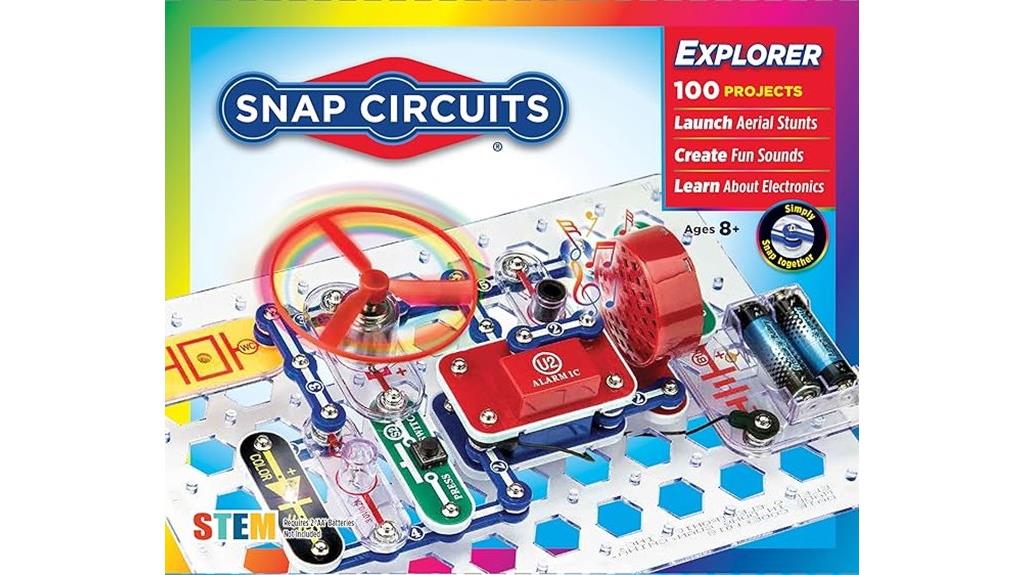
If you’re looking for an engaging way to introduce your child to the world of electronics, Snap Circuits Jr. SC-100 is a fantastic choice. Designed for kids aged 8 and older, this kit includes 28 components to create over 100 exciting projects, like a musical doorbell or voice-controlled lamp. The easy-to-follow manual features colorful illustrations that make learning fun and straightforward. Plus, with its high ratings and award recognition, you can trust its quality. As your child masters the basics, they can even customize their circuits, sparking creativity and a love for STEM learning. It’s truly an inspiring gift!
Best For: Children aged 8 and older who are interested in exploring electronics and STEM concepts.
Pros:
- Engaging hands-on learning experience with over 100 projects to build.
- High-quality components with a user-friendly manual featuring colorful illustrations.
- Strong customer support, including free replacement parts for wear and tear.
Cons:
- Requires 2 AA batteries, which are not included in the kit.
- Some projects may be too complex for younger children without adult supervision.
- Limited to the components included in the kit unless expanded with additional Snap Circuits kits.
Smartivity DIY Robotic Mechanical Hand STEM Toy for Kids 8-14 Years Old
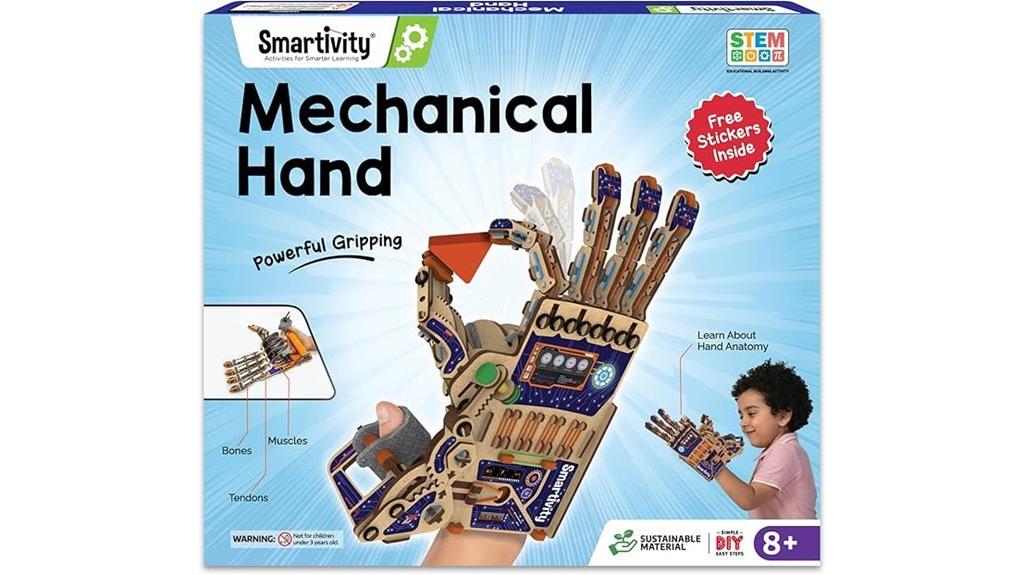
The Smartivity DIY Robotic Mechanical Hand STEM Toy stands out as an ideal choice for kids aged 8 to 14 who are keen to explore the world of engineering and robotics. This award-winning kit, made from high-quality engineered wood, is not only safe but also durable. I love how it reduces screen time while boosting creativity and confidence through hands-on building. The easy-to-follow instructions make assembly a breeze, and my kids are always engaged, even after construction. It’s perfect for family bonding and has received rave reviews, achieving a solid 4.6-star rating. This toy truly combines fun and learning in one package!
Best For: Kids aged 8 to 14 who are interested in engineering and robotics.
Pros:
- Encourages hands-on building, fostering creativity and confidence.
- Made from high-quality, sustainable materials ensuring durability and safety.
- Positive user feedback highlights ease of assembly and long-lasting engagement.
Cons:
- Some users noted limitations in the functionality of the robotic hand.
- May require adult supervision during assembly for younger kids.
- Initial construction can take time, which might not appeal to all children.
Discovery #MINDBLOWN Model Engine Building Kit
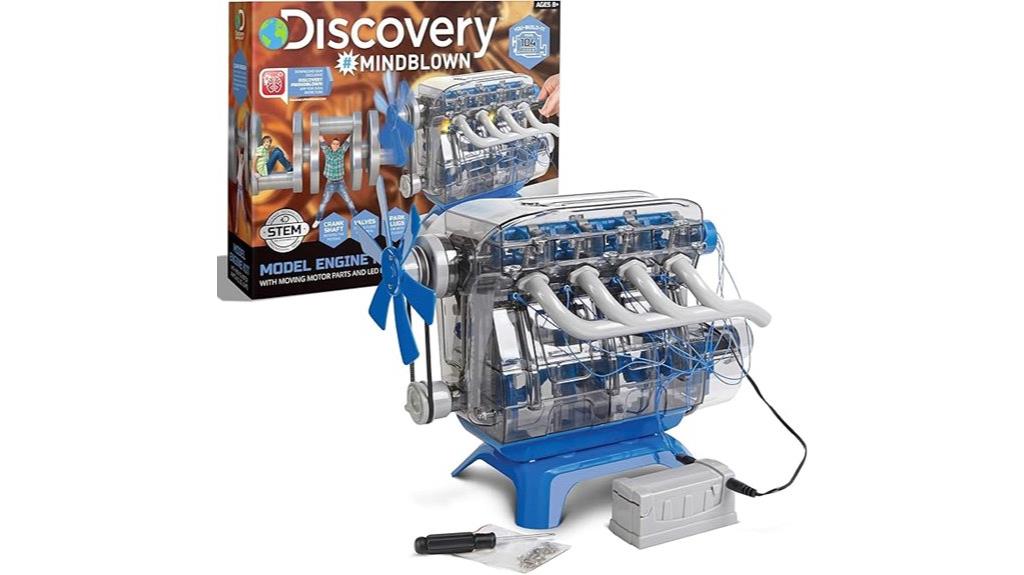
Kids who love hands-on projects and have a curiosity for how things work will find the Discovery #MINDBLOWN Model Engine Building Kit to be an exciting choice. This DIY 4-cylinder combustion engine features working pistons, valves, and even LED lights. Assembling it not only sparks creativity but also enhances logical thinking and motor skills. While some may find the small screws challenging, the satisfaction of building a functioning engine is worth it. Just remember, it’s recommended for ages eight and up, and requires a couple of AA batteries to get things running. It’s an engaging way to learn about mechanics!
Best For: Children aged 8 and up who are interested in mechanics and enjoy hands-on engineering projects.
Pros:
- Engages children in STEM learning through interactive assembly.
- Enhances creativity, logical thinking, and motor skills.
- Provides a fun and educational experience with working engine components.
Cons:
- Some assembly challenges due to small screws and complex instructions.
- Occasional issues with part durability, such as breaking connectors.
- Requires supervision for younger children, as it may not be suitable for all ages without assistance.
STEM Science Kits for Kids Ages 8-12
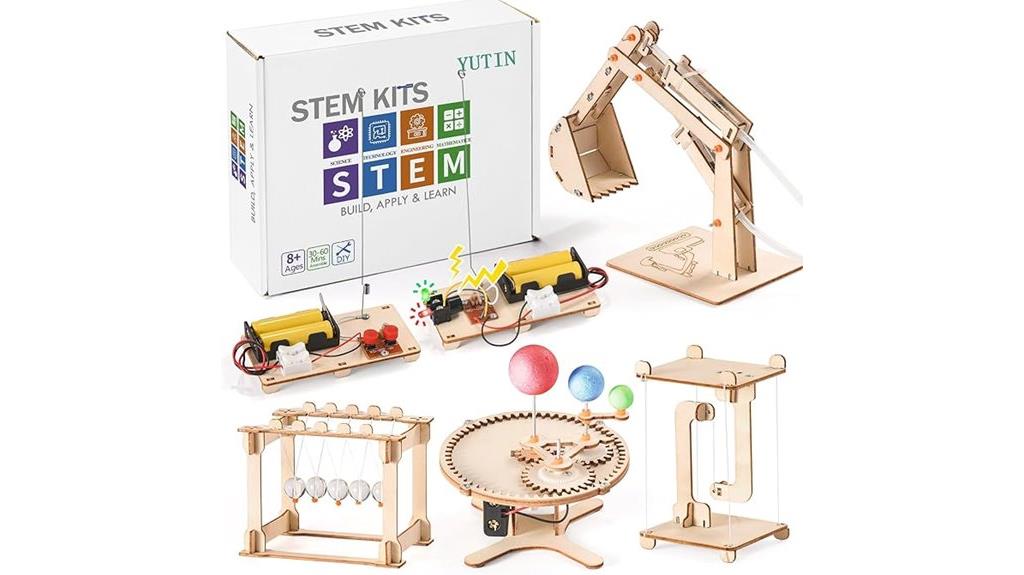
Designed for curious minds aged 8-12, these STEM Science Kits offer an engaging way to explore engineering and physics concepts through hands-on projects. With models like Newton’s Cradle and a Hydraulic Excavator, kids can immerse themselves in science while having fun. I love how these kits enhance understanding of energy conversion and motor functions. The detailed picture instructions make assembly a breeze, even if younger kids might need a little help. Made from non-toxic plywood, they’re safe and durable. Overall, these kits are not just educational; they’re perfect gifts that inspire creativity and a love for learning in science and engineering.
Best For: Kids aged 8-12 who are curious about science and enjoy hands-on learning experiences in engineering and physics.
Pros:
- Engages children in interactive learning through fun and creative projects.
- Enhances understanding of complex concepts like energy conversion and motor functions.
- Safe and durable materials ensure long-lasting use and safe assembly.
Cons:
- Some assembly instructions may be challenging for younger children without parental assistance.
- Certain parts may be fragile, leading to potential breakage during assembly.
- Varied complexity of projects may not suit all skill levels within the age range.
STEM Robotics Kits for Kids Age 5-14
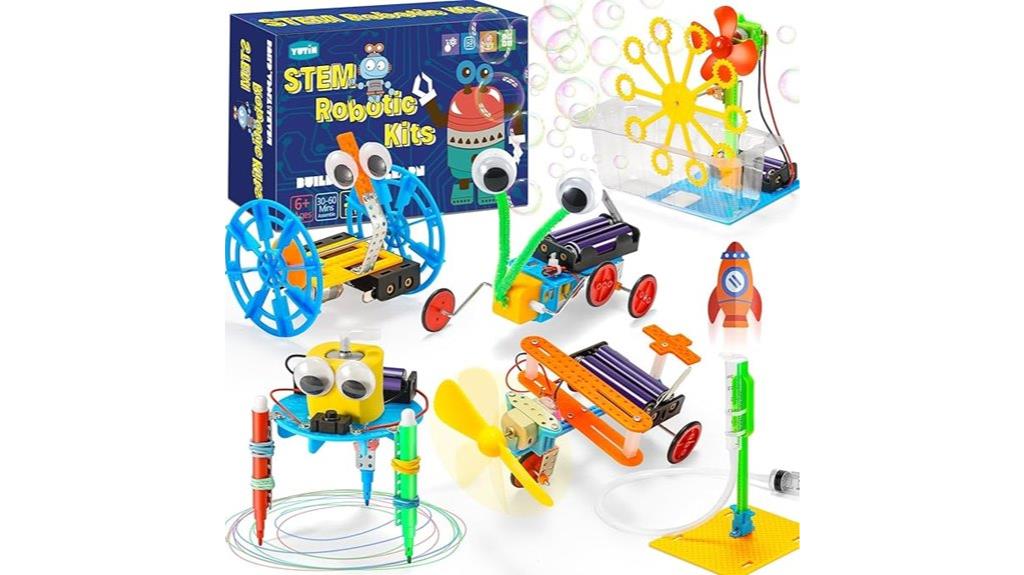
For young innovators aged 5-14, STEM Robotics Kits offer an exciting way to explore the world of science and engineering. I love how these kits include six unique robots, like a bubble machine and a doodling robot, providing endless fun and creativity. They encourage learning through play, making screen time more productive while developing problem-solving skills. Plus, assembling these kits can be a fantastic family bonding experience, creating unforgettable memories. Packaged beautifully, they make perfect gifts for any occasion. With illustrated instructions, kids can easily jump in, and the feedback speaks volumes about their quality and enjoyment.
Best For: Children aged 5-14 who are interested in science, technology, engineering, and mathematics through hands-on learning experiences.
Pros:
- Encourages creativity and problem-solving skills through engaging robotics projects.
- Provides a screen-time alternative that promotes family bonding and collaborative learning.
- Beautifully packaged, making it an ideal gift for birthdays or special occasions.
Cons:
- Younger children may require parental assistance with assembly.
- Some users report challenges with specific components during the building process.
- The complexity of certain projects may be a bit high for some kids within the age range.
“Hydrobot Arm Kit”, Hydraulic Kit, STEM Building Toy for Kids 12+

Looking for a hands-on way to ignite a love for engineering and science? The Hydrobot Arm Kit is perfect for kids aged 12 and up. This hydraulic STEM building toy operates using water, so there’s no need for batteries! With six axes of movement, the arm can rotate and bend in multiple directions, making it a fun challenge to assemble. I found the instructions clear, though filling the hydraulic system required some patience. Overall, it encourages problem-solving and analytical thinking. Just a heads-up: adult supervision might be needed for younger builders. It’s an educational gem that sparks creativity!
Best For: Kids aged 12 and up who are interested in hands-on STEM learning and engineering.
Pros:
- Encourages problem-solving skills and analytical thinking through engaging assembly.
- Operates without batteries, using hydraulic power, which adds an eco-friendly aspect.
- Provides a fun and educational experience that sparks creativity and interest in science.
Cons:
- Assembly can be time-consuming and may require adult supervision for younger builders.
- Filling the hydraulic system can be tricky and may lead to frustration if not done carefully.
- Some users reported durability issues after extended use, indicating it’s better for careful handling.
ButterflyEdufields STEM Projects Mini Engineering Kit for Kids
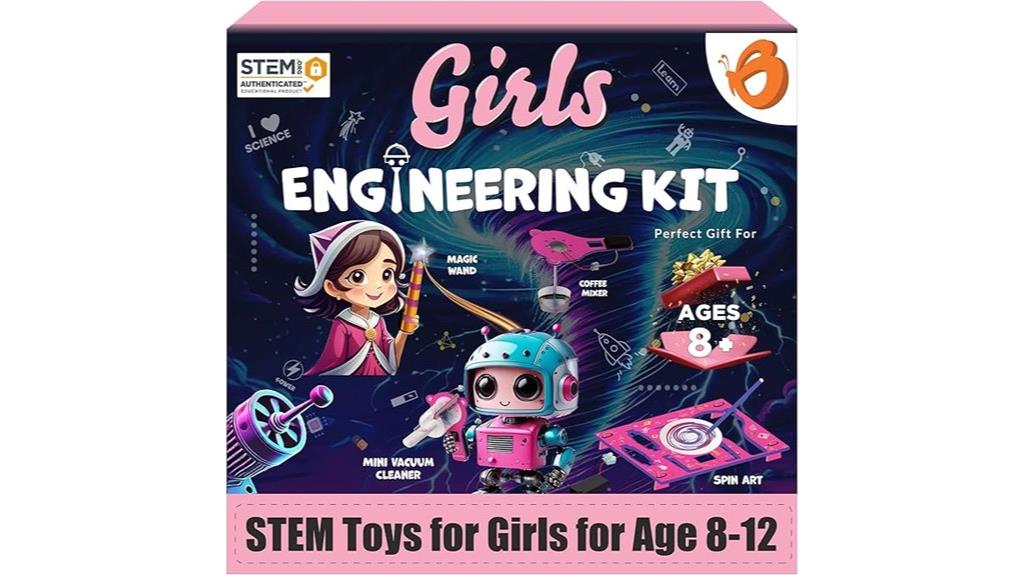
The ButterflyEdufields STEM Projects Mini Engineering Kit is a fantastic choice for kids aged 8 to 15 who are enthusiastic to plunge into the world of engineering and creativity. With over 50 pieces, this kit allows kids to build exciting projects like a vacuum cleaner, hovercraft, and magic wand. It’s designed to teach essential STEM concepts while empowering young minds, especially girls, to become problem solvers. The step-by-step instructions make it easy for both kids and adults to engage together. While some users reported minor quality issues, the overall fun and educational value far outweighs them. It’s a perfect gift for any occasion!
Best For: Children aged 8 to 15 who are interested in exploring engineering and creativity through hands-on STEM projects.
Pros:
- Engages kids in learning essential STEM concepts while fostering creativity and problem-solving skills.
- Includes a variety of projects that cater to different skill levels, making it suitable for both beginners and more experienced builders.
- Step-by-step instructions promote collaboration between kids and adults, enhancing the learning experience.
Cons:
- Some users reported issues with the fitment of pieces, leading to potential assembly difficulties.
- Certain components, like the plastic volcano, may not perform as well as expected, impacting the overall experience.
- Minor quality control concerns have been noted, suggesting room for improvement in future iterations of the kit.
Engino Inventor STEM Toys Multimodel Set for Kids 6

Engino Inventor STEM Toys Multimodel Set is perfect for young creators aged 6 and up who crave hands-on engineering experiences. This award-winning kit allows kids to build various models while developing essential STEM skills like 3D thinking and creative problem-solving. With easy-to-follow instructions, children can construct complex structures and enjoy the interactive 3D app for a virtual building experience. I love how the durable pieces are compatible with other Engino kits, expanding play possibilities. This set makes an ideal gift for budding engineers, but I recommend supervising younger kids to avoid frustration with the complexity.
Best For: The Engino Inventor STEM Toys Multimodel Set is best for children aged 6 and up who are interested in building and engineering.
Pros:
- Encourages hands-on learning and develops critical STEM skills.
- Easy-to-follow instructions that make it accessible to young learners.
- Durable construction with compatibility with other Engino kits for expanded play.
Cons:
- Some users reported missing pieces in the set.
- Instructions may be challenging for younger children, leading to frustration.
- Complexity of certain models may not be suitable for all children in the age range.
NATIONAL GEOGRAPHIC Da Vinci Catapult Model Kit for Kids

For young inventors aged 12 and up, the NATIONAL GEOGRAPHIC Da Vinci Catapult Model Kit stands out as an exceptional choice in the domain of kids’ engineering kits. This 3D puzzle building toy lets kids construct three fascinating machines: a catapult, ballista, and bombard. I love how these models can launch projectiles up to 15 feet, making for exciting play. The assembly takes 1-3 hours, and with quality materials and clear instructions, it’s a rewarding experience. I recommend this kit for fostering creativity and problem-solving skills, perfect for those ready to tackle a hands-on STEM project.
Best For: This model kit is best for kids aged 12 and up who are interested in engineering and hands-on STEM projects.
Pros:
- High-quality materials and clear instructions make assembly enjoyable and educational.
- Encourages creativity and problem-solving skills through building three different machines.
- Positive customer feedback highlights the fun and engaging nature of the models, with projectiles launching up to 15 feet.
Cons:
- Some users report missing parts in their packages, which can hinder the building experience.
- Assembly can be challenging for younger children and may require adult supervision.
- Certain components may need adjustments or repairs for optimal performance.
ELEGOO UNO R3 Smart Robot Car Kit for Arduino Robotics
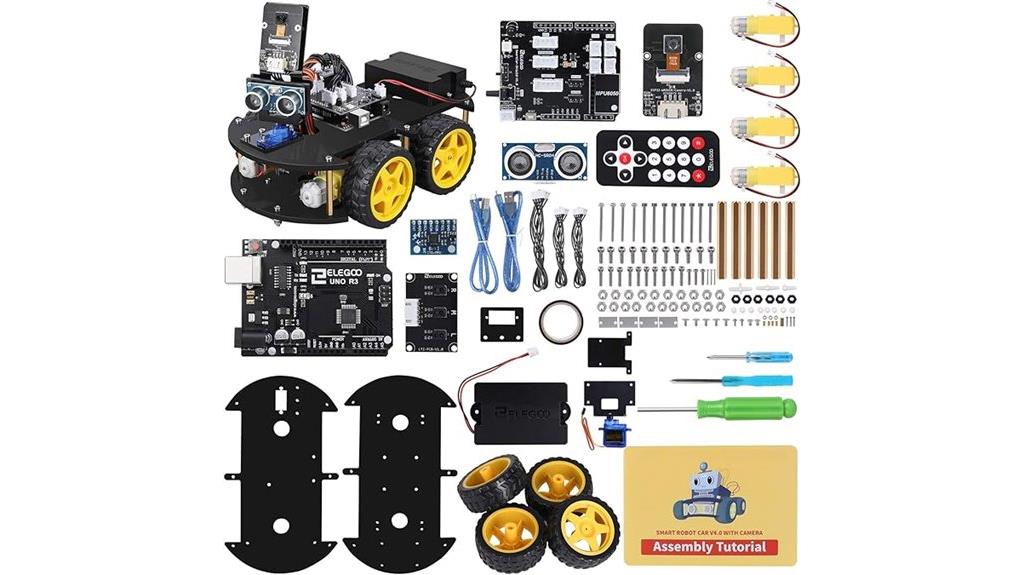
Looking for a hands-on way to spark interest in programming and robotics for kids aged 8-16? The ELEGOO UNO R3 Smart Robot Car Kit is an excellent choice. With 24 modules, including obstacle avoidance and line tracing features, it makes learning fun! I found the assembly straightforward, thanks to clear instructions, though beginners might need a little extra help. The car runs on pre-loaded code, so you can dive right in. Plus, there’s room for customization, letting kids get creative. Overall, it’s a fantastic introduction to robotics that keeps the excitement alive while teaching essential STEM skills.
Best For: Kids aged 8-16 who are interested in programming, robotics, and hands-on learning experiences.
Pros:
- Engaging and fun way to learn programming and robotics concepts.
- Easy assembly with clear instructions, making it user-friendly for experienced builders.
- Customizable features allow for creative modifications and enhancements.
Cons:
- Beginners may find assembly and programming instructions complex without additional guidance.
- Remote control range is limited, and WiFi connection can be sensitive to distance and interference.
- Some users report that the robot’s speed can be excessive, requiring code adjustments to manage.
Makeblock mBot Robot Kit for Kids (Ages 8-12)
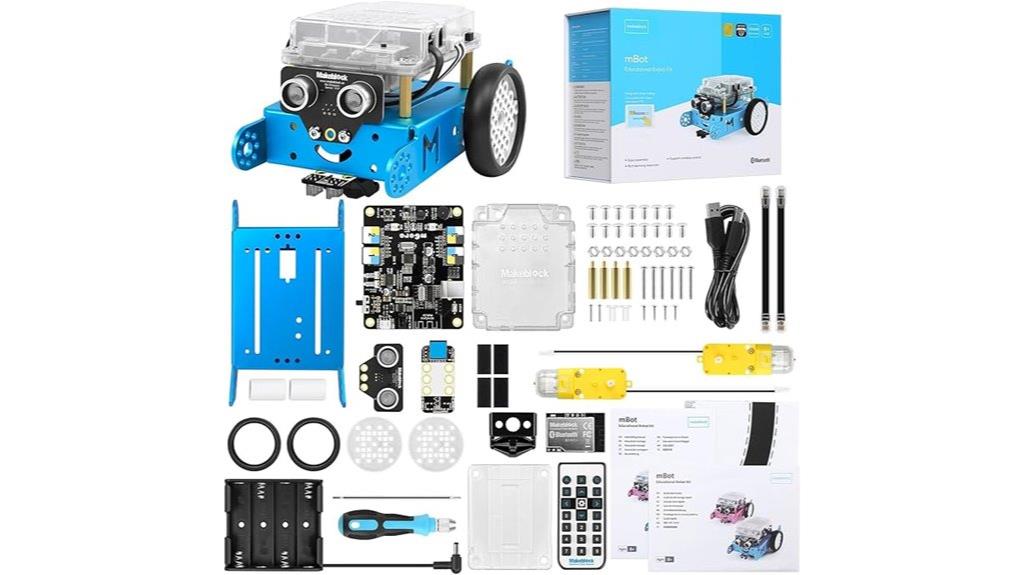
The Makeblock mBot Robot Kit stands out as an exceptional choice for children aged 8 to 12 who are enthusiastic to plunge into the exciting worlds of electronics, robotics, and programming. With easy assembly in just 15 minutes, it quickly becomes a remote control car that can follow lines and avoid obstacles. The kit includes rich tutorials and coding cards, making learning fun and interactive. Plus, it’s compatible with LEGO and over 100 electronic modules, enhancing creativity. Rated 4.6 stars, it’s an ideal gift that sparks curiosity and provides hours of educational enjoyment for both boys and girls.
Best For: Children aged 8 to 12 who are interested in learning about electronics, robotics, and programming.
Pros:
- Easy assembly in just 15 minutes, making it accessible for kids.
- Engaging tutorials and coding cards that promote interactive learning.
- Compatible with LEGO and over 100 electronic modules, fostering creativity.
Cons:
- Some users report a need for clearer programming tool download instructions.
- The learning curve may be progressive, which could challenge younger users.
- Limited advanced features may not engage older children as much.
Factors to Consider When Choosing Kids’ Engineering Kits
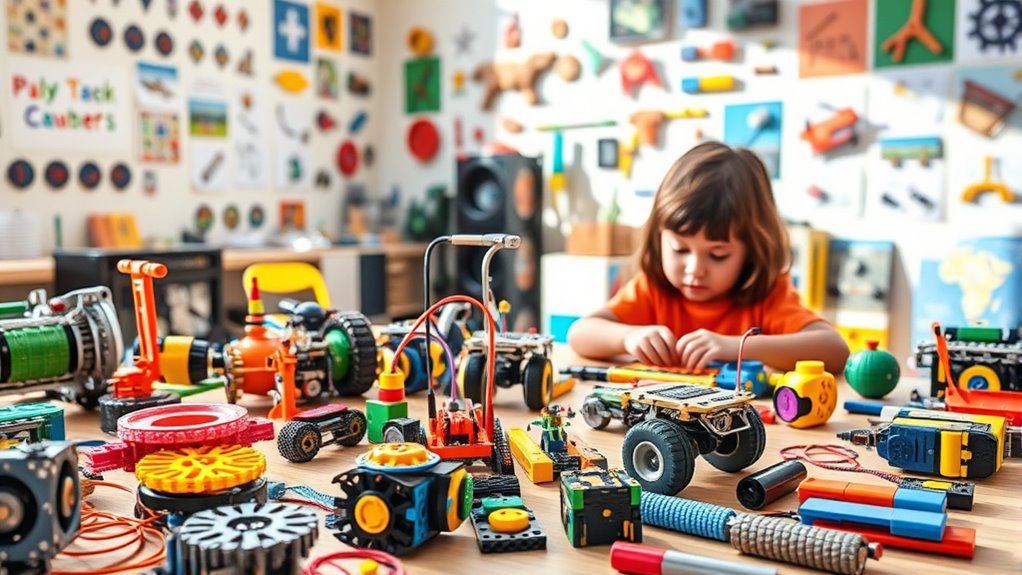
When picking out an engineering kit for kids, I always consider a few key factors. It’s crucial to think about age appropriateness, educational value, and safety of materials to guarantee a positive experience. I also look at assembly difficulty and project variety to keep things engaging and fun.
Age Appropriateness
Selecting the right engineering kit for kids hinges on age appropriateness, as each kit is typically designed with specific age ranges in mind that reflect its complexity and safety features. For younger children, ages 3-5, kits focus on basic motor skills and simple assembly. As kids grow, those aged 6-10 engage in hands-on activities that introduce STEM concepts in a fun way without overwhelming them. Kits for older children, ages 8-12, often involve intricate concepts and advanced problem-solving skills. Remember, children may need adult supervision for these kits, especially if small parts are involved. Choosing a kit that aligns with your child’s developmental stage guarantees they feel challenged yet capable, enhancing their overall learning experience.
Educational Value
Choosing an engineering kit for kids isn’t just about fun; it’s also about educational value. I always look for kits that emphasize STEM learning, as they help develop critical skills like problem-solving and creativity through hands-on activities. Many kits engage children for 1-2 hours, enhancing their concentration and hand-eye coordination. I appreciate those that include step-by-step instructions with visual aids, making complex concepts accessible for various ages. It’s important to select kits tailored to specific age groups, ensuring the projects match the child’s developmental abilities and interests. I’ve noticed that customer feedback often highlights how these kits spark an interest in engineering and technology, with many parents reporting improved skills and enthusiasm in their kids after using them.
Assembly Difficulty
Understanding assembly difficulty is essential for ensuring a positive experience with kids’ engineering kits. I’ve noticed that the clarity of instructions plays a huge role; some kits use only images, which might need adult supervision for younger builders. I’ve also found that small parts and intricate designs can be challenging, especially for kids who aren’t quite ready for advanced fine motor tasks. Some kits can take hours or even days to assemble, which might frustrate less experienced users. Plus, I’ve read feedback about needing extra tools like screwdrivers, so it’s vital to check what’s required before starting. Remember, if assembly demands multiple attempts to get it right, it could dampen the fun and learning experience.
Project Variety
When you plunge into the world of kids’ engineering kits, you’ll quickly realize that project variety can greatly impact a child’s engagement and learning. Kits like the HOMETTER Educational Building Toys offer ten different designs, keeping play fresh and exciting. I love how sets like Engino STEM Toys let kids explore various engineering concepts, from buildings to bridges, fostering creativity and problem-solving skills. Interactive features, such as 3D apps or augmented reality, elevate the building experience, making learning feel modern and dynamic. It’s also essential to choose kits that mix simple and complex designs, allowing kids to grow their skills progressively. Finally, look for kits that encourage customization and expansion, enabling endless project possibilities that ignite a child’s imagination!
Safety and Materials
As I explore the domain of kids’ engineering kits, the importance of safety and materials quickly becomes clear. I always prioritize non-toxic, child-safe materials to minimize any risk during play. It’s essential to choose kits made from durable materials that can withstand the rigorous handling kids put them through. I also look for kits with smooth surfaces and rounded edges to prevent cuts or injuries while assembling. Checking for safety certifications or compliance with standards reassures me that the product has been tested for hazardous materials. Additionally, I pay attention to age recommendations, as they often indicate the safety and complexity of the materials included, ensuring a suitable and enjoyable experience for young engineers.
Interactive Features
Choosing the right kids’ engineering kit goes beyond safety and materials; interactive features play a significant role in enhancing the overall experience. I love kits that incorporate augmented reality apps or 3D virtual building, as they let kids visualize their projects in an engaging way. Hands-on activities are essential too, encouraging critical thinking and problem-solving skills while children experiment with different components. Some kits even offer interactive quizzes or challenges that make learning STEM concepts fun and competitive. Animated instruction manuals can improve comprehension, making assembly easier and more enjoyable. Plus, kits with programmable components, like sensors or motors, allow kids to create interactive models that respond to their inputs, boosting creativity and innovation in their projects.
Frequently Asked Questions
Are These Kits Suitable for Beginners in Engineering?
When I first explored engineering kits, I found many were perfect for beginners. They often come with clear instructions and engaging projects that make learning fun. I noticed that these kits allow kids to experiment and build confidence as they create. Honestly, I think anyone new to engineering will appreciate how accessible and exciting these kits are. They provide a fantastic starting point for sparking interest and developing problem-solving skills.
What Age Range Do These Kits Cater To?
Have you ever wondered if there’s a perfect age for sparking creativity in engineering? I’ve found that many of these kits cater to a wide range, typically from ages 5 to 14. They’re designed to grow with your child, offering challenges that evolve as their skills develop. So, whether your little one’s just starting out or ready for more complex projects, there’s likely something that’ll capture their interest and fuel their imagination!
Do These Kits Require Any Additional Tools or Materials?
I’ve found that many of these kits are designed to be self-contained, so they don’t typically require extra tools or materials. Most come with everything needed to get started, which makes it easy for kids to dive right in. However, some projects might suggest having basic household items on hand, like scissors or tape. I always check the kit details to see if anything extra’s needed before starting a project.
Are the Components Safe and Non-Toxic for Kids?
Imagine a world where your child’s creativity blossoms without worry. When I immerse myself in these engineering kits, safety’s my top priority. Most kits I’ve explored are designed with non-toxic materials, ensuring my little builder can tinker away without harm. I always check for safety certifications, too, just to be sure. It’s such a relief knowing the components are safe, allowing my child to focus on creating and learning with joy.
How Long Does It Typically Take to Complete These Projects?
When I tackle these projects, I usually find they take anywhere from a couple of hours to a few days, depending on the complexity. Some kits have straightforward builds that I can finish quickly, while others require more time to figure out and assemble. I enjoy the challenge, though! It’s all about immersing myself in the process, learning along the way, and enjoying the satisfaction of seeing my hard work come to life.
Conclusion
Choosing the right engineering kit for your child can feel like exploring a maze—exciting yet overwhelming. But just like building a bridge, it’s all about finding the right pieces to connect creativity and learning. Whether your little one dreams of constructing towering skyscrapers or programming a robot, there’s a kit that’ll ignite their passion. So, immerse yourself, explore the options, and watch as their imagination takes flight—after all, every great engineer started with a spark of curiosity!
